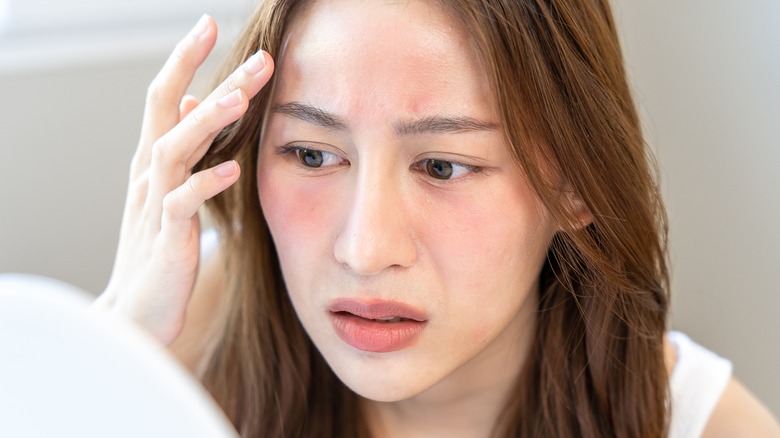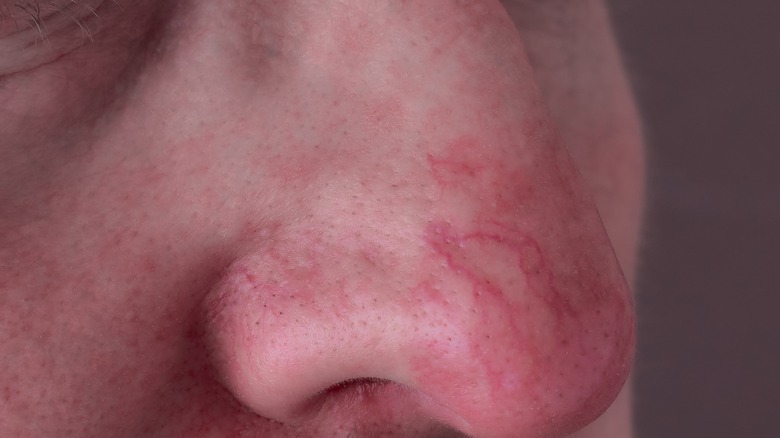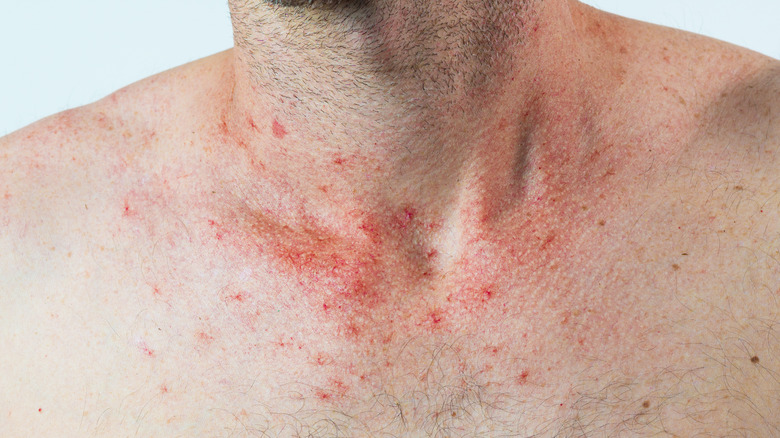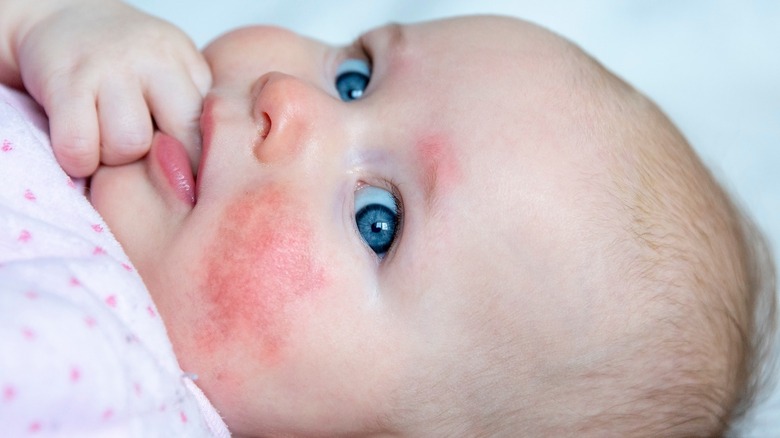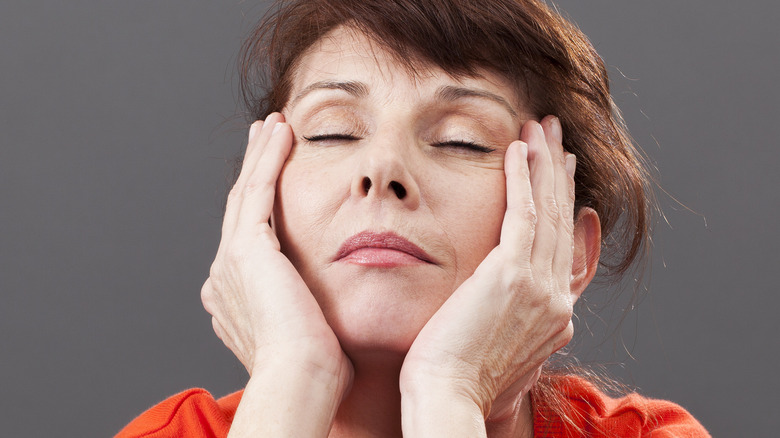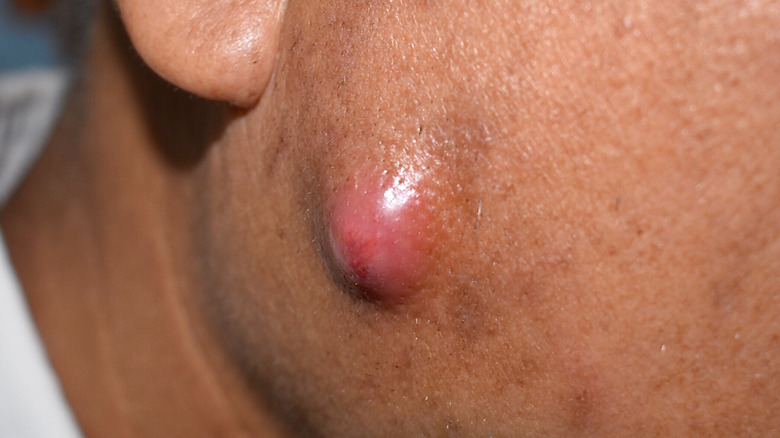What May Be Causing Redness In Your Face And How To Fix It
It's common knowledge that a crimson face belongs to someone who's shy, embarrassed, or super excited about something. That's why many people tend to assume that facial redness is induced by strong emotions or intoxication. As Santa Clara University explains it, emotions trigger your breathing rate, causing your pupils to dilate and hundreds of blood vessels to open wide to get more oxygen. As more blood rushes to your face, the redness in your face becomes more noticeable. Basically, blushing is an involuntary response.
Intense emotions and severe anxiety aside, there's a wide array of less obvious reasons for facial redness. For instance, chilly weather can cast a red tint on your pale cheeks, but so can acne and allergic reaction. Facial redness can signify a clinical symptom that needs medical attention. According to Buoy, flushed skin triggered by a medical condition is usually characterized by redness across the face, spidery blood vessels most noticeable on the cheek and nose, stinging bumps, and bloodshot eyes. Here are several reasons why your face is red and how you can treat it.
Rosacea
One of the most common skin conditions that make your facial blood vessel become as striking as red ink and result in flushed skin alongside pus-filled bumps is rosacea, per the Mayo Clinic. For this reason, rosacea is typically mistaken for acne. The initial signs of rosacea include redness across the face and a burning sensation when using skincare products. You might also get bloodshot eyes, itchy eyelids, bumpy skin, and a swollen nose from rosacea. While these symptoms aren't life-threatening, you should have them checked by a medical specialist for a proper diagnosis and treatment. If left untreated, these symptoms might progress into a form of advanced rosacea and take a toll on your physical well-being.
Rosacea is more common among middle-aged white women, but it can also be found in men. There's no permanent cure for rosacea, which can persist for a while and disappear all of the sudden. The way to keep your symptoms in check is to stay hydrated (via the National Rosacea Society) because dehydration exacerbates your symptoms. Cold water helps to prevent your blood vessels from dilating, which is the leading cause of rosy cheeks. At the same time, you might want to cut down on stimulants that might expand your blood vessels, such as caffeinated drinks, cigarettes, and sweet foods.
Spider veins
Spider veins, or broken blood vessels, form when blood vessels are enlarged and accumulate in veins just beneath the skin's surface, causing the skin to be flushed and red. These thin and damaged veins that recall spider webs are a mild symptom of varicose vein disease, a condition triggered by increased blood pressure in the veins, per the Vein Clinics of America. Apart from prominent redness, spider veins can also cause itchiness and cramping. The most common causes of spider veins, per The New Jersey Vein & Vascular Center, are unprotected sun exposure, pregnancy, consumption of alcohol, and aging. Spider veins are also visible among people who suffer from rosacea, liver disease, or connective tissue disorders. Apart from the face, you'll likely see spider veins on the legs, feet, and chest area.
Genetics, excessive weight gain, hormonal changes, and trauma can put you at risk of developing spider veins. Therefore, a healthy lifestyle with regular exercises and fiber-packed can aid in boosting vein health. To prevent spider veins from getting worse, always heap on sunscreen before going out and use compression stockings to prevent blood from pooling in veins. For more advanced treatment to get rid of spider veins, resort to laser therapy or intense pulsed light to eliminate abnormal veins.
Eczema
According to Medical News Today, eczema, a common type of atopic dermatitis, is a condition that causes the skin to be inflamed, resulting in itchy, flaky red patches in the affected skin. Eczema rash is characterized by intense itchiness that comes with a burning sensation. The red appearance of eczema flare-ups is most visible among those with lighter skin, while brown and grey patches tend to be more common among those with darker skin. Most people with eczema can't resist the urge to scratch the inflamed skin to relieve their itchiness, which makes the itchy spots even itchier and vulnerable to infections. Albeit not contagious, eczema can happen to both babies and adults. To stave off flares, avoid irritants and triggers such as soaps, detergents, extreme temperatures, stress, and habitual scratching, per Patient.
As far as treatment goes, your doctor may offer patch testing to evaluate how your skin reacts to different levels of drugs and provide an accurate diagnosis. Inflammation-fighting medicines such as cyclosporine, methotrexate, prednisone, mycophenolate, and azathioprine are commonly administered to people with severe eczema.
Menopause
According to Lifespan, a dreadful burst of a warm sensation rushing throughout the body, alongside red and blotchy skin, are common symptoms of menopause. During this period, estrogen production drops, the ovaries cease producing eggs, and periods become sporadic. Caused by hormonal fluctuations in the body, hot flashes, flushed skin, and night sweats usually end once you're post-menopausal.
For some people, hot flashes last for a short amount of time during menopause while for others, they can prolong for decades. Flares of heat that last a long time usually get more severe over time. While menopause itself doesn't need medical attention, there are ways to keep your hot flashes in check and relieve menopausal discomfort. Counting among them are hormone therapy, low-dose antidepressants, and the use of Gabapentin, the Mayo Clinic points out. Also, try to figure out what triggers your flares, be it alcohol, spicy food, or hot weather. Getting enough sleep and practicing relaxing techniques such as deep breathing or guided imagery also help with menopausal symptoms.
Cellulitis
Redness in the skin can also be caused by cellulitis, a bacterial skin infection that, if left untreated, can pose critical health problems. According to the Centers for Disease Control and Prevention, cellulitis is also characterized by aching, swelling, and blisters in the affected skin, which are typically accompanied by chills or fever. The inflamed skin, when touched, feels warm and tender. Cellulitis, per Skinsight, is caused by the bacteria Streptococcus or Staphylococcus, which penetrate the skin through open wounds and accumulate into chockfull of ulcers. When you spot symptoms of cellulitis, seek medical attention as soon as possible. Early treatment with antibiotics is essential in keeping the symptoms in check. Cellulitis can appear anywhere on the body, from your face to your legs. Diabetes, open wounds, edema, obesity, poor immune system, and bites from both insects, animals, and humans can put you at risk of developing cellulitis.
Because numerous illnesses can cause redness in your face, getting an early diagnosis and proper treatment is critical in preventing your conditions from getting worse. Some home remedies are effective against flushed skin, but it's better to know exactly what causes it and develop healthy habits to steer clear of triggers. Your untrained eye can't discern the underlying cause of your skin issue, so refrain from self-medicating yourself with any pill or ointment the Internet suggests.
